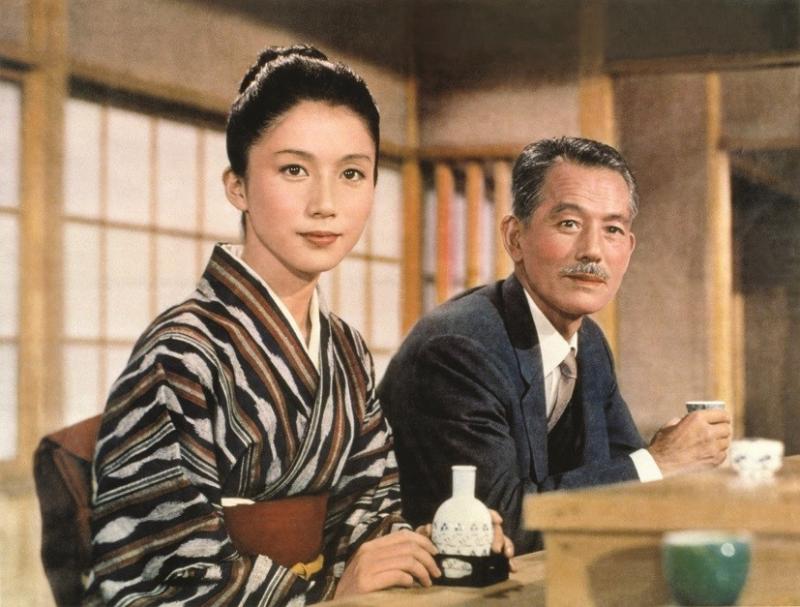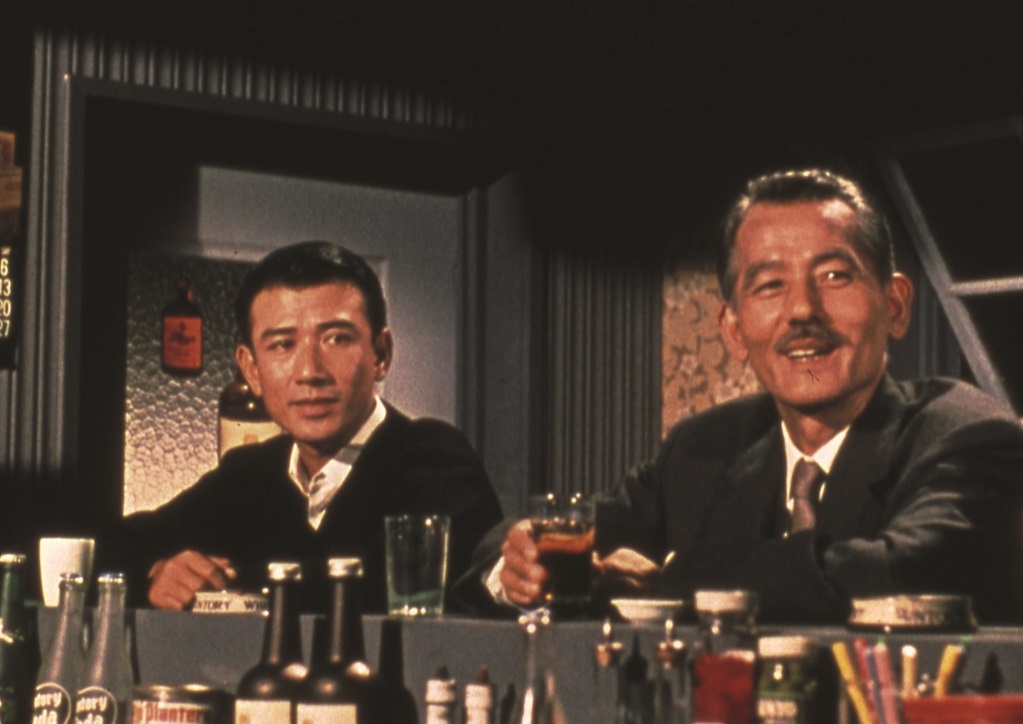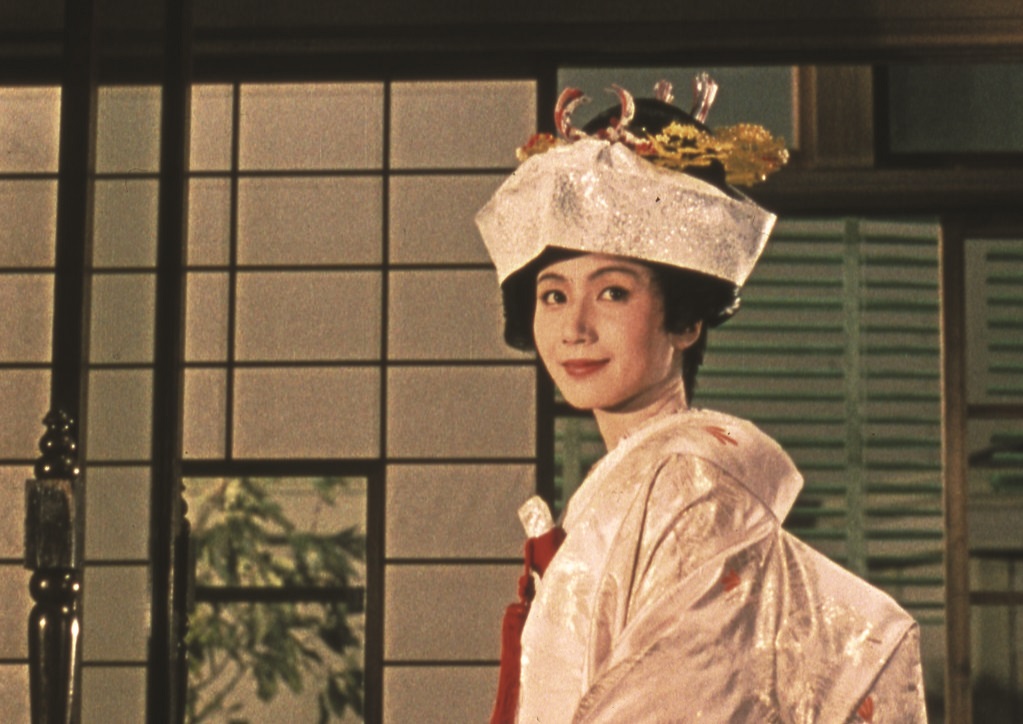An Autumn Afternoon | reviews, news & interviews
An Autumn Afternoon
An Autumn Afternoon
Final film from Japanese master Yasujiro Ozu is unforgettable cinema

The classic Japanese director Yasujiro Ozu named a number of his films after the seasons, but he restricted himself to spring, summer and autumn. I don’t believe he ever titled one after winter - not that his work doesn’t touch on the closing of the year, and its associations with death.
It's no surprise that Ozu returned to his recurring theme of parents and children, known best from his 1953 masterpiece Tokyo Story. While that earlier work was about how the younger generation had little time for their parents, An Autumn Afternoon poignantly shows how a father (played by Chishu Ryu, the director’s longterm collaborator, not least in Tokyo Story) subtly presses his daughter towards marriage and an independent future, even though her departure from his home leaves emptiness behind.
The colour cinematography is wonderful at dabbing patches of bright colour onto an otherwise restrained canvas
We first encounter the father in his office environment – and so come to know him by his surname, Hirayama – and from the first scene the issue of female employees leaving work to marry is being mentioned. He’s a salaryman in a factory (the chimneys of which brightly open the film: this was one of six films that Ozu made in colour), and we later learn that he served in the navy during the war. His life out of the office includes regular drinking sessions with old friends, and at one of them, a school reunion, the guest is an old schoolteacher, who’s known only as “the Gourd” (due, we presume, to his ability to imbibe plentifully: Eijiro Tono plays a beautiful cameo, and frequently steals the scenes in which he appears). Delivering the tipsy teacher home at the end of the evening, Hirayama discovers that he has been reduced to running a noodle shop, looked after by his discontented daughter, who has never married.
 Returning to his own home, he’s greeted by his daughter Michiko (the luminous Shima Iwashita): Hirayama is a widower, and she looks after him – greeting him every time he comes home a little the worse for wear with a mild reproach – as well as her younger brother, keeping the home in order. An elder brother Kochi (Keiji Sada) is already married, living the new consumerist lifestyle with his assertive wife (Akika Hirayama, more fine comedic playing). The sense of the differing values of the older and new generation is subtly caught in the latter’s relationship, where domestic tasks are shared, and the subject of family disputes is whether the next purchase should be a new domestic appliance or something more frivolous (Kochi finally gets his golf clubs, even if he has to pay for them in instalments, and playing golf in Tokyo anyway involves firing balls at a target set up on the roof of a skyscraper).
Returning to his own home, he’s greeted by his daughter Michiko (the luminous Shima Iwashita): Hirayama is a widower, and she looks after him – greeting him every time he comes home a little the worse for wear with a mild reproach – as well as her younger brother, keeping the home in order. An elder brother Kochi (Keiji Sada) is already married, living the new consumerist lifestyle with his assertive wife (Akika Hirayama, more fine comedic playing). The sense of the differing values of the older and new generation is subtly caught in the latter’s relationship, where domestic tasks are shared, and the subject of family disputes is whether the next purchase should be a new domestic appliance or something more frivolous (Kochi finally gets his golf clubs, even if he has to pay for them in instalments, and playing golf in Tokyo anyway involves firing balls at a target set up on the roof of a skyscraper).
Ozu is a master of intonation (the frequent "h'mm" which speaks more than any words) and nuance, and the sense of a changing society, moving from the legacy of war towards industrial boom, is everywhere, not least in the differences of costume, from the traditional kimono to new western styles. The gentlemen’s working attire is strict three-piece suits, which become progressively more rumpled as the sake goes down - there’s a lot of imbibing in the film (pictured above right, Hirayama with his eldest son Kochi, played by Keiji Sada). The colour cinematography, by Ozu’s favourite lenser Yuharu Atsuta, is wonderful at dabbing patches of bright colour onto an otherwise restrained canvas, and the city of Tokyo itself still looks somehow modest, naïf, a far cry from the visual extravagance that we associate with it today.
 There’s very much a sense of emancipation for women in the air too, of moving beyond the traditional roles that society had accorded them. A final melancholy for Michiko comes, after she has accepted the idea of marriage, when she discovers that the man she had had feelings for has become engaged to another woman, having assumed that Michiko would indeed go on looking after her father. The film does end with marriage, even if it’s something of a negotiated one, and we never actually see the formal ceremony, only its preparations and aftermath. In the process of those discussions the brilliant Iwashita manages a scene, a silent trajectory of the eyes, which is truly haunting (pictured above left).
There’s very much a sense of emancipation for women in the air too, of moving beyond the traditional roles that society had accorded them. A final melancholy for Michiko comes, after she has accepted the idea of marriage, when she discovers that the man she had had feelings for has become engaged to another woman, having assumed that Michiko would indeed go on looking after her father. The film does end with marriage, even if it’s something of a negotiated one, and we never actually see the formal ceremony, only its preparations and aftermath. In the process of those discussions the brilliant Iwashita manages a scene, a silent trajectory of the eyes, which is truly haunting (pictured above left).
There are wells of sadness behind the banter, oceans of humanity alongside the bitter-sweet formality of behaviour and family drama (I couldn’t help thinking somehow of Mike Leigh, but Leigh played at 16 rpm). There’s something strangely Chekhovian there as well, catching the Russian writer’s sense of life both going on, and simultaneously receding into the past. Music from another Ozu collaborator Kojun Saito is also utterly distinctive from the director’s work, something spare that approaches but never broaches the sentimental. Both that and the visuals are perfect in this new restoration from Shochiku Studios, which was where Ozu worked for his whole life. An Autumn Afternoon comes very close to perfection. Glorious.
The future of Arts Journalism
You can stop theartsdesk.com closing!
We urgently need financing to survive. Our fundraising drive has thus far raised £49,000 but we need to reach £100,000 or we will be forced to close. Please contribute here: https://gofund.me/c3f6033d
And if you can forward this information to anyone who might assist, we’d be grateful.

Subscribe to theartsdesk.com
Thank you for continuing to read our work on theartsdesk.com. For unlimited access to every article in its entirety, including our archive of more than 15,000 pieces, we're asking for £5 per month or £40 per year. We feel it's a very good deal, and hope you do too.
To take a subscription now simply click here.
And if you're looking for that extra gift for a friend or family member, why not treat them to a theartsdesk.com gift subscription?
more Film
 Bugonia review - Yorgos Lanthimos on aliens, bees and conspiracy theories
Emma Stone and Jesse Plemons excel in a marvellously deranged black comedy
Bugonia review - Yorgos Lanthimos on aliens, bees and conspiracy theories
Emma Stone and Jesse Plemons excel in a marvellously deranged black comedy
 theartsdesk Q&A: director Kelly Reichardt on 'The Mastermind' and reliving the 1970s
The independent filmmaker discusses her intimate heist movie
theartsdesk Q&A: director Kelly Reichardt on 'The Mastermind' and reliving the 1970s
The independent filmmaker discusses her intimate heist movie
 Blu-ray: Wendy and Lucy
Down-and-out in rural Oregon: Kelly Reichardt's third feature packs a huge punch
Blu-ray: Wendy and Lucy
Down-and-out in rural Oregon: Kelly Reichardt's third feature packs a huge punch
 The Mastermind review - another slim but nourishing slice of Americana from Kelly Reichardt
Josh O'Connor is perfect casting as a cocky middle-class American adrift in the 1970s
The Mastermind review - another slim but nourishing slice of Americana from Kelly Reichardt
Josh O'Connor is perfect casting as a cocky middle-class American adrift in the 1970s
 Springsteen: Deliver Me From Nowhere review - the story of the Boss who isn't boss of his own head
A brooding trip on the Bruce Springsteen highway of hard knocks
Springsteen: Deliver Me From Nowhere review - the story of the Boss who isn't boss of his own head
A brooding trip on the Bruce Springsteen highway of hard knocks
 The Perfect Neighbor, Netflix review - Florida found-footage documentary is a harrowing watch
Sundance winner chronicles a death that should have been prevented
The Perfect Neighbor, Netflix review - Florida found-footage documentary is a harrowing watch
Sundance winner chronicles a death that should have been prevented
 Blu-ray: Le Quai des Brumes
Love twinkles in the gloom of Marcel Carné’s fogbound French poetic realist classic
Blu-ray: Le Quai des Brumes
Love twinkles in the gloom of Marcel Carné’s fogbound French poetic realist classic
 Frankenstein review - the Prometheus of the charnel house
Guillermo del Toro is fitfully inspired, but often lost in long-held ambitions
Frankenstein review - the Prometheus of the charnel house
Guillermo del Toro is fitfully inspired, but often lost in long-held ambitions
 London Film Festival 2025 - a Korean masterclass in black comedy and a Camus classic effectively realised
New films from Park Chan-wook, Gianfranco Rosi, François Ozon, Ildikó Enyedi and more
London Film Festival 2025 - a Korean masterclass in black comedy and a Camus classic effectively realised
New films from Park Chan-wook, Gianfranco Rosi, François Ozon, Ildikó Enyedi and more
 After the Hunt review - muddled #MeToo provocation
Julia Roberts excels despite misfiring drama
After the Hunt review - muddled #MeToo provocation
Julia Roberts excels despite misfiring drama
 London Film Festival 2025 - Bradley Cooper channels John Bishop, the Boss goes to Nebraska, and a French pandemic
... not to mention Kristen Stewart's directing debut and a punchy prison drama
London Film Festival 2025 - Bradley Cooper channels John Bishop, the Boss goes to Nebraska, and a French pandemic
... not to mention Kristen Stewart's directing debut and a punchy prison drama
 Ballad of a Small Player review - Colin Farrell's all in as a gambler down on his luck
Conclave director Edward Berger swaps the Vatican for Asia's sin city
Ballad of a Small Player review - Colin Farrell's all in as a gambler down on his luck
Conclave director Edward Berger swaps the Vatican for Asia's sin city

Add comment